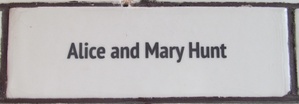Died:
Married:
Children:
Alice Hunt and her sister, Mary, were factory girls from New York City; in 1885, they were the first two patients in Little Red, the first cottage of the Adirondack Cottage Sanitarium.
An autobiography, Edward Livingston Trudeau, pp. 168-172
After securing a site and some crude plans for the proposed humble little structure, I put the building business into Mr. Riddle's helpful hands and turned my attention to the matter of securing someone to run the place. I had no more idea about what sort of a staff I needed or could procure with the limited means at my command than I had about the architectural requirements of a sanitarium for the open-air treatment of tuberculosis. I finally waded in, as usual, and hired M. J. Norton, a man who had been a small farmer in the region, and made an agreement with him for a year for his services in doing the outside work of the place, and for the services of his wife and two daughters, one eighteen and the other fifteen, to take charge of the housekeeping and inside work. He was also to furnish his horse and cart. Of course none of these people had ever heard of a sanitarium, or had the slightest idea of what it was intended to do, except to furnish board and lodging to a few invalids.
The building of a little rough-board barn and a portion of the main building had progressed sufficiently by the middle of the summer of 1884 to enable Mr. Norton to move his family in and live on the place, and late in the fall Dr. Loomis sent up the first two patients—two sisters, both factory girls; one, Alice Hunt, had pulmonary tuberculosis, and the other, Mary Hunt, had had Pott's disease and now showed slight evidences of pulmonary tuberculosis as well. Dr. Loomis had found someone willing to pay their expenses and had sent them up on this account, as nothing would have been done for them at their home, a crowded tenement. They were both in wretched health, poorly clad to stand the Adirondack winter cold, and were nearly dead with fatigue when they reached the Sanitarium after a forty-two mile drive from Ausable Forks. Mrs. Norton and her daughters took them right into the family circle, my wife got some warm clothes for them, and I examined them and advised them as to what to do, and encouraged them to the best of my ability.
At that time only the foundations and frame of the first little cottage had been built, and the cottage was not completed and occupied until February 1, 1885. In looking at it now it seems rather curious why it should have been delayed so long, for it certainly was a most modest undertaking; but with neither men nor money available, I imagine Mr. Riddle did all that could be done under the circumstances. This first cottage consisted of one room, fourteen by eighteen, and a little porch so small that only one patient could sit out at a time, and with difficulty. It was furnished with a wood stove, two cot-beds, a washstand, two chairs and a kerosene lamp, and cost, as I remember, about four hundred dollars when completed. The money was obtained by Mr. C. M. Lea from a Mrs. Jenks, a lady in Philadelphia.
This humble little building has become somewhat historical now, and has always been known at the Sanitarium as "The Little Red." Humble as it undoubtedly is, it was nevertheless the pioneer cottage in the development of the sanatorium treatment in America, and has stood for a great principle of treatment which will long survive the little building. At present it is kept in repair as a relic, and used as a little museum for other relics connected with the history of the institution.
"Memory and mental imagery" are certainly a wonderful piece of human mechanism, for now, looking back over the long span of thirty years, I can distinctly see the Adirondack Cottage Sanitarium in all its incongruous details, in the midst of its beautiful natural environment of mountains and unbroken forest. The grounds were a rough hillside covered with scant grass, through which everywhere jutted boulders of varying sizes, a few rising four or five feet above the ground. Not a sidewalk, not a path anywhere! The buildings, a small rough-board and shingle barn, one unpainted wing of the main building without any porch, and one small unpainted cottage! The patients, two frail, ill-clad factory girls! The staff, a farmer, his wife and two daughters—all this humble agglomeration situated in an unbroken forest forty-two miles from the nearest railroad! Truly, I must have been an optimist by nature, and the joy of life and youth must have run in my veins then, for I was not in the least discouraged as I viewed my old fox runway, now ruined for hunting purposes. I don't know what Fitz Hallock thought of it, but I am quite sure that under the circumstances he hardly shared my enthusiasm.




